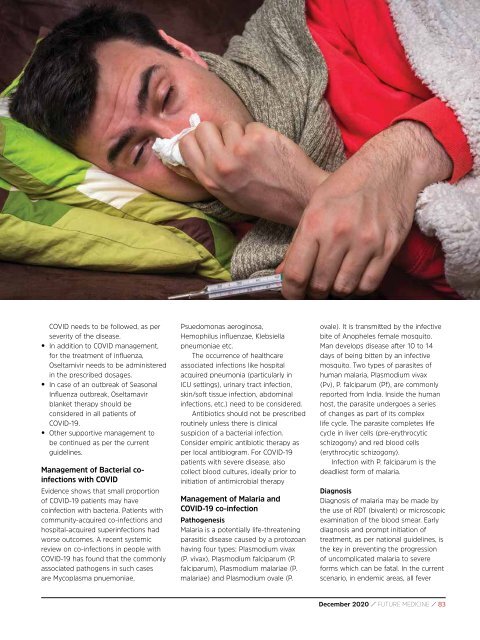Create successful ePaper yourself
Turn your PDF publications into a flip-book with our unique Google optimized e-Paper software.
COVID needs to be followed, as per<br />
severity of the disease.<br />
• In addition to COVID management,<br />
for the treatment of influenza,<br />
Oseltamivir needs to be administered<br />
in the prescribed dosages.<br />
• In case of an outbreak of Seasonal<br />
Influenza outbreak, Oseltamavir<br />
blanket therapy should be<br />
considered in all patients of<br />
COVID-19.<br />
• Other supportive management to<br />
be continued as per the current<br />
guidelines.<br />
Management of Bacterial coinfections<br />
with COVID<br />
Evidence shows that small proportion<br />
of COVID-19 patients may have<br />
coinfection with bacteria. Patients with<br />
community-acquired co-infections and<br />
hospital-acquired superinfections had<br />
worse outcomes. A recent systemic<br />
review on co-infections in people with<br />
COVID-19 has found that the commonly<br />
associated pathogens in such cases<br />
are Mycoplasma pnuemoniae,<br />
Psuedomonas aeroginosa,<br />
Hemophilus influenzae, Klebsiella<br />
pneumoniae etc.<br />
The occurrence of healthcare<br />
associated infections like hospital<br />
acquired pneumonia (particularly in<br />
ICU settings), urinary tract infection,<br />
skin/soft tissue infection, abdominal<br />
infections, etc.) need to be considered.<br />
Antibiotics should not be prescribed<br />
routinely unless there is clinical<br />
suspicion of a bacterial infection.<br />
Consider empiric antibiotic therapy as<br />
per local antibiogram. For COVID-19<br />
patients with severe disease, also<br />
collect blood cultures, ideally prior to<br />
initiation of antimicrobial therapy<br />
Management of Malaria and<br />
COVID-19 co-infection<br />
Pathogenesis<br />
Malaria is a potentially life-threatening<br />
parasitic disease caused by a protozoan<br />
having four types: Plasmodium vivax<br />
(P. vivax), Plasmodium falciparum (P.<br />
falciparum), Plasmodium malariae (P.<br />
malariae) and Plasmodium ovale (P.<br />
ovale). It is transmitted by the infective<br />
bite of Anopheles female mosquito.<br />
Man develops disease after 10 to 14<br />
days of being bitten by an infective<br />
mosquito. Two types of parasites of<br />
human malaria, Plasmodium vivax<br />
(Pv), P. falciparum (Pf), are commonly<br />
reported from India. Inside the human<br />
host, the parasite undergoes a series<br />
of changes as part of its complex<br />
life cycle. The parasite completes life<br />
cycle in liver cells (pre-erythrocytic<br />
schizogony) and red blood cells<br />
(erythrocytic schizogony).<br />
Infection with P. falciparum is the<br />
deadliest form of malaria.<br />
Diagnosis<br />
Diagnosis of malaria may be made by<br />
the use of RDT (bivalent) or microscopic<br />
examination of the blood smear. Early<br />
diagnosis and prompt initiation of<br />
treatment, as per national guidelines, is<br />
the key in preventing the progression<br />
of uncomplicated malaria to severe<br />
forms which can be fatal. In the current<br />
scenario, in endemic areas, all fever<br />
<strong>December</strong> <strong>2020</strong> / FUTURE MEDICINE / 83

















